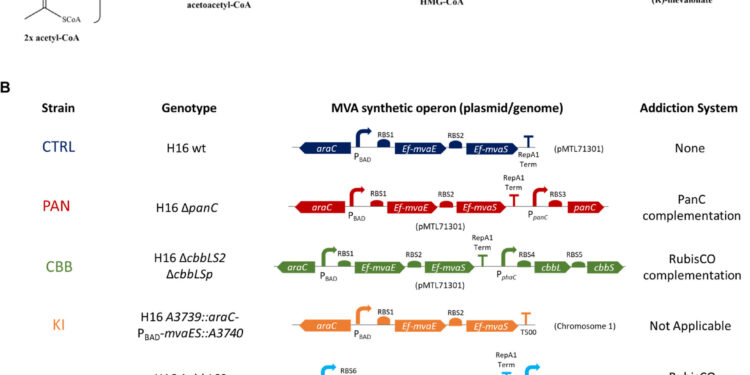Schematic representation of the upper MVA pathway and summary of C. necator H16-derived strains used in this study. Credit: ACS Sustainable Chemistry and Engineering (2024). DOI: 10.1021/acssuschemeng.4c03561
While some microbes can make people sick or spoil food, others are essential to survival. These tiny organisms can also be engineered to produce specific molecules. Researchers report in ACS Sustainable Chemistry and Engineering have reprogrammed one of these microbes to help combat greenhouse gases in the atmosphere: it absorbs carbon dioxide (CO2) gas and produces mevalonate, a useful building block for pharmaceuticals.
The increasing concentration of greenhouse gases in the atmosphere has led to widespread global warming. To begin to address the problem, greenhouse gas emissions, particularly CO2must be significantly reduced. In addition, CO2 already present could be deleted.
CO capture methods2 Research is ongoing, and one of the most promising options involves microbes. Genetic engineering can alter their natural biosynthetic pathways, turning microbes into miniature living factories capable of producing all sorts of things, like insulin.
Cupriavidus necator H16 is a bacterium that could be a microbial factory, as it is relatively undemanding about what it is fed. In fact, it can survive on little more than CO2 and hydrogen, the bacteria is a great candidate for capturing and converting the gases into larger molecules. But while the microbe’s DNA can be reprogrammed to produce interesting products, it’s not very good at remembering those new instructions over time.
To put it scientifically, plasmids (genetic instructions) are relatively unstable. Katalin Kovacs and her colleagues wanted to see if they could improve C. necator’s ability to memorize its new instructions and produce useful carbon-based building blocks from CO2 gas.
The team set to work hacking C. necator’s biochemical pathways responsible for CO conversion2 into larger six-carbon molecules. The key to improving plasmid stability lies in an enzyme called RubisCo, which allows the bacteria to use CO2.
In fact, the new plasmid was coupled to the enzyme, so that if a cell failed to memorize the new instructions, it would fail to remember how to make RubisCo and would die. Meanwhile, the remaining cells, with better memories, would survive and replicate, passing on the plasmid.
In tests, the newly created microbes produced significantly more mevalonate, a six-carbon molecule, than a control strain. Mevalonate is a molecular building block for all sorts of substances in living and synthetic systems, including cholesterol and other steroid molecules with pharmaceutical applications. In fact, this research produced the largest quantities to date of mevalonate from CO2 or other single-carbon reagents using microbes.
The researchers say it is a more economically viable carbon fixation system than previous systems involving C. necator, and could also be extended to other microbial strains.
More information:
Marco Garavaglia et al., Stable platform for the bioproduction of mevalonate from CO2, ACS Sustainable Chemistry and Engineering (2024). DOI: 10.1021/acssuschemeng.4c03561
Provided by the American Chemical Society
Quote: Improving microbial memory to better recycle excess CO₂ (2024, August 30) retrieved August 30, 2024 from
This document is subject to copyright. Apart from any fair dealing for the purpose of private study or research, no part may be reproduced without written permission. The content is provided for informational purposes only.



